Well, here we are – closing in on year two of this global pandemic. Are you as over it as we are?
Looking back at 2020, one of the defining movements of DJing was the overwhelming adoption of live streaming. With most of the world entering one form of lockdown or another, DJs flocked to sites like Twitch, Instagram, and Facebook Live to connect with an audience. While many DJs had been streaming previously, the dam burst in at the start of the pandemic.
With 2021 behind us, things have opened up in many places worldwide. That means gigs are back in full force for many – for better or worse.
Playing for real-life people again has been amazing – albeit a bit anxiety-inducing. There are, however, only so many hours in a day, and some of us haven’t been able to maintain a regular streaming schedule now that gigging has come back.
On the other hand, some DJs developed a healthy fanbase that spans the globe simply through live streaming. So disappointing – or giving up – the experience and the revenue of live streaming in place of live gigs becomes a difficult choice.
How can you do both?
Well, one straightforward way is to start live streaming at your gigs. But how would you go about doing this?
Bringing the whole shebang
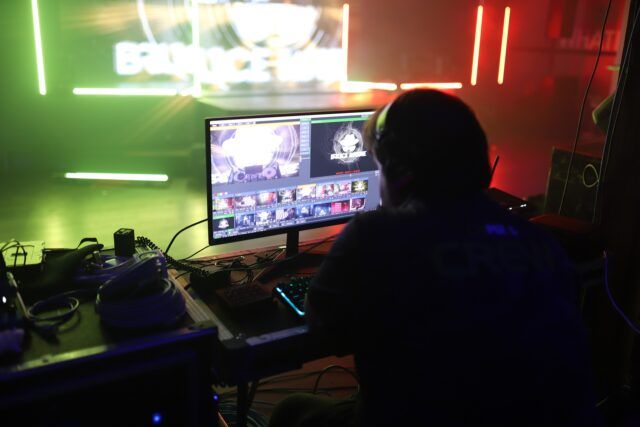
One option is to bring your full OBS set up on the road. Grab an extra laptop, bring some cameras, and try to translate your stream to your gigs.
Pros:
- The closest to your usual setup – Bringing all your gear will maintain the same familiarity you have with your home setup.
- The most dynamic option for your streaming fanbase – If your audience expects a certain level of quality from your streams, you can maintain some of that with a proper OBS setup. Multiple camera angles, visuals, cat gifs you can pop up at a moment’s notice – all possible with a good OBS setup.
- The highest quality broadcast – Let’s be real here; nothing will beat a proper PC-based setup with quality cameras for streaming. People will notice if your streaming rig consists of thousands in gear, cameras, and streaming PCs. If you need to high level of production value during a stream, then this is really the only way to go.
Cons:
- More gear to bring and setup/teardown – Do you want to go to every gig with a bunch of extra stuff? Not only is it more gear to bring, but it’s also more gear to set up and tear down at the end of the day.
- More attention needed (or someone to handle your stream) – With a streaming setup, you’re essentially running a second performance. Especially true if you want to flip through multiple camera angles or trigger visual effects in OBS. When you’re djing for real-life people, you focus on the crowd in front of you. Adding another aspect that requires attention could be overwhelming – or requiring a dedicated streaming engineer to your team. I personally only try to livestream at mellow, background music gigs.
- Less interaction with your stream – Performing for real-life people and performing for people on a livestream are very different experiences. I’m sure your live audience won’t appreciate the same level of mic work you generally expect from a stream. Telling people to throw up their emojis in the chat while playing for a real-life audience will likely be confusing, if not downright cringeworthy. Streaming at your gigs becomes more of a passive experience for your online audience than an interactive experience. While this can be a bit of a hit to your livestream, it is one of the compromises you may need to make when streaming your performances.
- Bandwidth issues – Public or even business WiFi will always be a roll of the dice. Relying on public WiFi for something as data-intensive as a livestream is a risk.
Not the move for you? Consider an alternative.
Bringing a full OBS setup feels very much like a production – something you would want for an online concert or broadcasting a high-profile gig to an established following. But what about those of us that don’t need or want such a lavish production? What if we want to broadcast one of our regular residencies, or stream from a house party?
An easy solution: mobile streaming
One option is to stream directly from your phone. While much less dynamic and more no-frills, it’s an option and requires minimal extra gear and setup.
What you’ll need:
- Mobile phone with internet access – Duh.
- A controller or mixer with a secondary or third output – Since you’re playing live, you will need to output to the venue’s speakers. You also need a separate signal to your streaming device, so you’ll need a controller with at least two separate outputs. A third will be required if you also want to have monitors. Single output devices like the Mixtrack Pro or the DDJ-400 will require a separate mixer with multiple outputs.

- Some type of mobile sound card – Now that headphone ports are becoming a thing of the past, an audio interface is essential. Even older phones with a headphone port are not the most ideal. Phone inputs are often explicitly designed for microphone input and will only input mono instead of stereo.
- Tripod – you can get a host of phone tripods anywhere – from Amazon to a brick and mortar camera store.
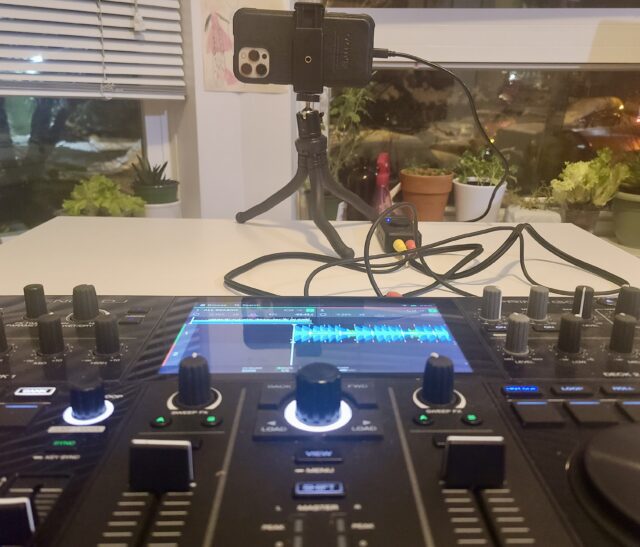
- A reliable data plan – If your venue has reliable WiFi, this isn’t a huge deal. If not, you will have to use your phone data. Streaming uses up a fair amount of data. Depending on the streaming resolution, you use anywhere from 250 MB to over a gigabyte of data per hour.
Choosing the right mobile sound card
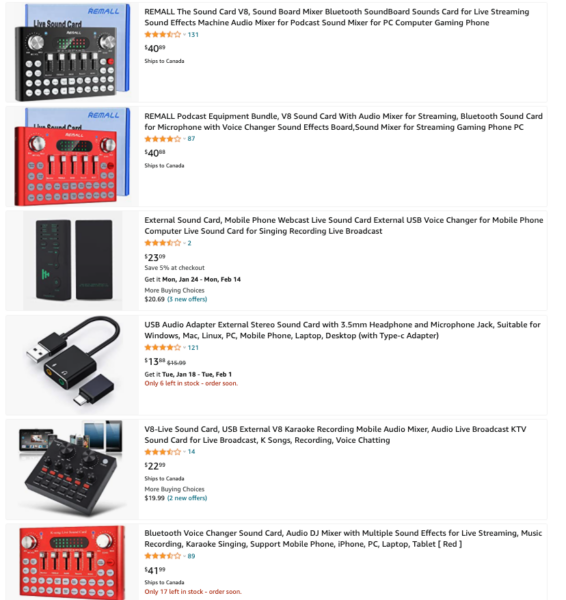
There are a wide variety of mobile sound cards available that are compatible with phones or tablets. Some are from reputable companies, others from unknown companies that only ever appear in the darkest corners of Amazon. While there are plenty of options – including using class-compliant sound cards with USB adaptors – we will focus on two of the highest-profile companies making these dedicated cards. IK Multimedia and Roland should be easily recognizable names to anyone interested in music and audio gear.
Roland
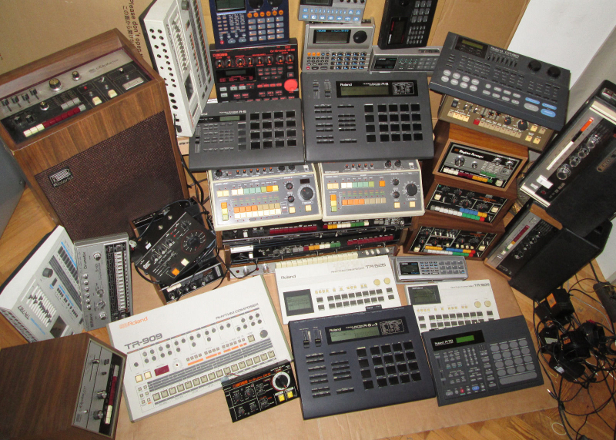
The Roland name and reputation are legendary. You hear their synths and drum machines on countless tracks over the decades. The iconic TR series of drum machines (and other classic synths) played a pivotal role in the genesis of modern electronic dance music. The GO:MIXER line is Roland’s portable sound cards and mixers – explicitly designed for mobile devices like smartphones and tablets. We’ll be looking at the original GO:MIXER and the recently refreshed GO:MIXER Pro X.
Note: Roland offers a third option in the GO:LIVECAST for mobile streaming, but we will focus on the original GO:MIXER and the GO:MIXER Pro X.
IK Multimedia
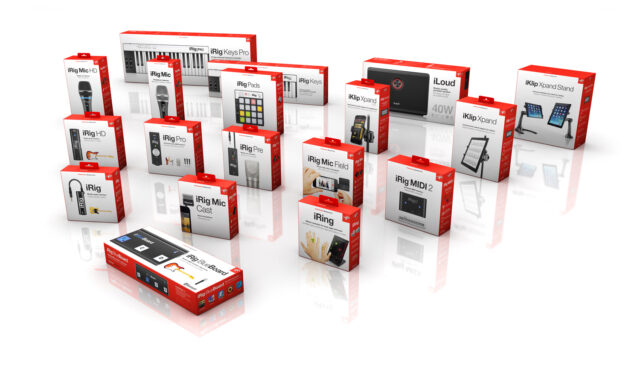
IK Multimedia doesn’t have quite the historical reputation of Roland, but it has quietly built up an array of products. Their product line spans everything from interfaces to synths and studio monitors. However, the one thing that most people associate with their brand is the iRig series of mobile phone audio interfaces. So while Roland has more of a reputation in the music industry, they are the relative newcomer to the mobile audio interfaces. While there are many iRigs to choose from, we will be looking at the iRig Stream and the iRig Pro Duo. These are stereo-capable interfaces that would appeal the most to DJs.
Note: Since this article’s writing, IK Multimedia has released the iRig Stream Pro, which offers a more robust set of features. We were unable to secure a unit for this article in time for publishing.
Both companies provide both a budget, entry-level card and a more professional option. We’re going to compare and contrast these and highlight some strengths and weaknesses of each.
Entry-level choices
Priced at about $100, these are the lower-cost options for mobile sound cards.
Roland GO:MIXER
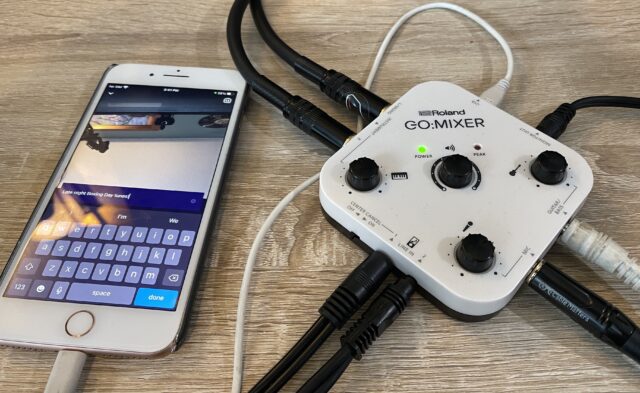
Author’s note: I have the most experience with the Roland GO:MIXER as it was my mobile sound card for a couple of years. It has seen countless livestreams both at home and at gigs. However, it is also very hard to find these days and may only be available used.
The GO:MIXER is essentially an 8in-2out sound card and mixer. There are two stereo 1/8″ ins, a pair of 1/4″ ins for either two mono instruments or a single stereo input. It also sports an additional mono 1/4″ in, and a 1/4″ mic input. The output consists of a single, 1/8″ headphone jack. This card can function as a full mixer, allowing you to connect stereo lines, mono instruments, and microphones. Most of these inputs include dedicated volume knobs. The GO:MIXER also includes a Center Cancel option which reduces audio elements in the center of the stereo mix.
Build quality:
The GO:MIXER honestly feels a bit cheap in its build. The knobs feel super wobbly and the plastic feels low quality. It doesn’t feel like it would survive a drop from a decent height.
Pros:
- Inputs – For the price, you get a ridiculous amount of inputs – including three separate stereo inputs.
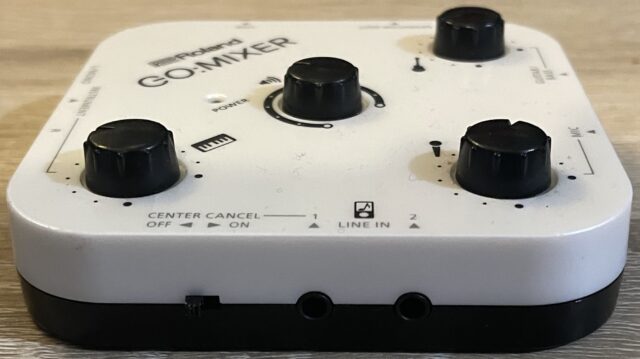
- Functions as a hardware mixer – With so many inputs, the GO:MIXER gives you remarkable versatility and allows multiple setups to stream from the same interface. You can connect instruments, synths, drum machines, samplers, and more and jam out to your heart’s content.
- Functions as a standalone mixer – Connect a USB battery pack, and you don’t even need a phone connected. You can power the mixer, hook it up to a speaker, and connect whatever gear you want.
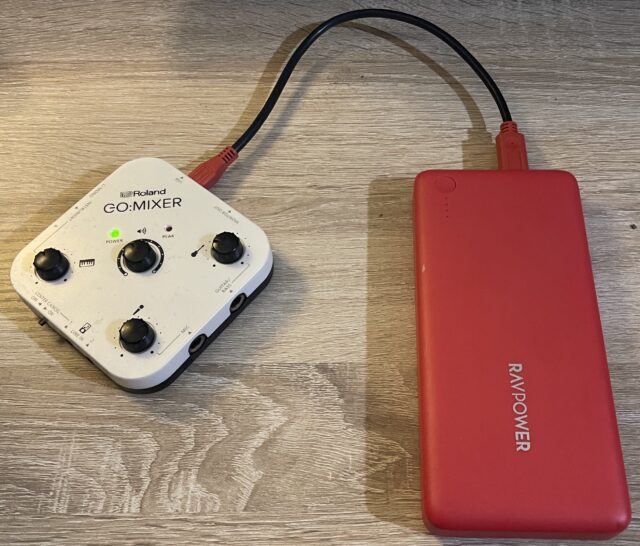
- Mic input – As mentioned above, the amount of mic work DJs tend to do in livestreams is far more than acceptable for gigs. With the dedicated mic input on the GO:MIXER, you can converse directly with your livestream audience without broadcasting to your venue.
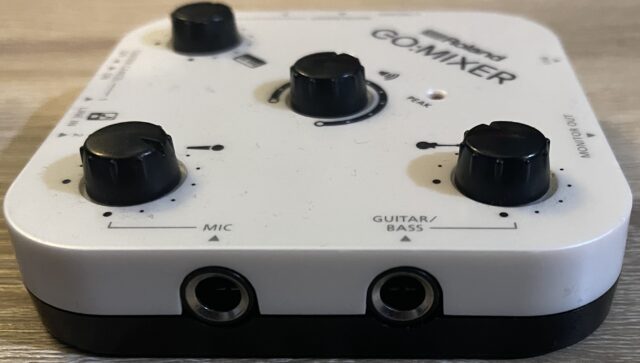
- Size – It’s compact and portable. It should easily fit in any bag or even your pocket.
Cons:
- Micro-USB connection – This type of connection was never my favourite, but my included cable is already starting to go (I need to apply pressure on it or lose the connection). I’m experiencing this after a year of regular use.
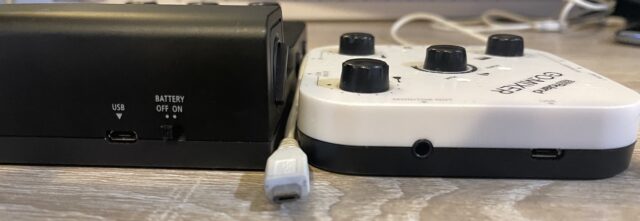
- Distorts easily – I find it kind of touchy with gain inputs. You need to be on top of your gain staging and leave plenty of headroom – which ends up being a little quiet for livestreaming. I’ve heard it distort well before the peak light hits if you put too much volume into the inputs. I’ve also experienced the GO:MIXER distorting over long sessions, but that might be because of my dying USB cable.
- USB bus-powered only – The GO:MIXER uses your phone or tablet’s battery to supply power, which can quickly drain even the most robust battery in a few hours.
- It doesn’t work with a camera connection adaptor – Many mobile phone devices are compatible with a camera connection adaptor dongle allowing you to simultaneously connect the device and charge via a USB battery pack. Unfortunately, the Roland GO:MIXER does not function when using one of these dongles.
- Mic input setup – requires an unbalanced TS cable instead of a TRS cable.
- Difficult to find – I haven’t gotten a clear answer from Roland as to whether the GO:MIXER is discontinued, or whether we will be seeing a refresh. As of now, it seems the used market is the only place to find them.
IK Multimedia iRig Stream
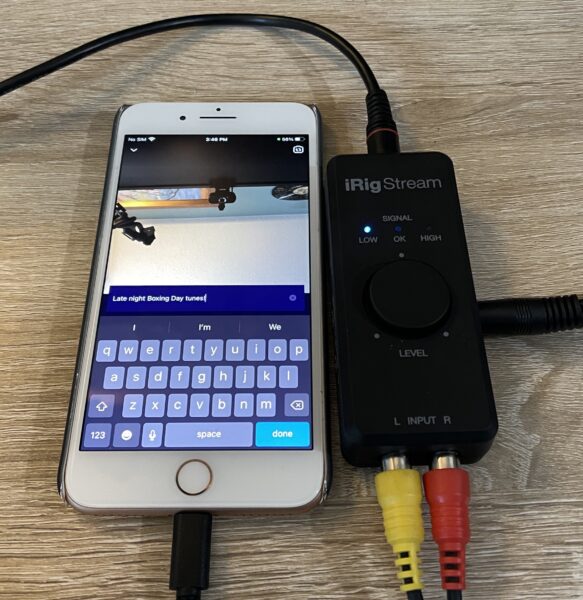
The smallest option, this little pocket-sized interface is relatively straightforward and no-frills. The iRig Stream is a fairly (pardon the pun) streamlined card. It includes a pair of RCA inputs, a headphone/microphone 1/8″ jack, a large volume knob, some smaller volume dials, and a couple of switches.
Build quality:
The iRig stream is pretty light but feels decently solid. Smaller in size, it has a bit more of a sturdy feel. It lacks standard, protruding knobs and only has a flat, circular disk as a control. This unconventional control makes the knob feel a little less flimsy than more traditional knobs. Additional volume controls use embedded dials that feel sturdy if a little finicky. Additional features like mono summing and loopback use compact switches that click into place. The plastic has a soft-touch, rubbery finish that some like and others don’t.
Pros:
- Level lights – I like the IK Multimedia design for level light. It has a peak light, but a low-level LED light lets you know if the signal is too quiet.
- RCA Inputs – This is the only card reviewed that contains standard RCA inputs. It’s one of the most common ports for audio so most DJs should have several lying around.
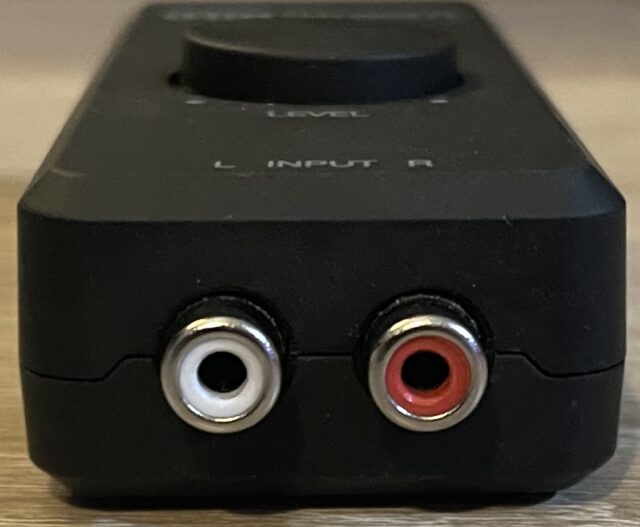
- DIN connector for the connection cable – I find this connecter way sturdier and more secure than the micro-USB connector on the GO:MIXER.
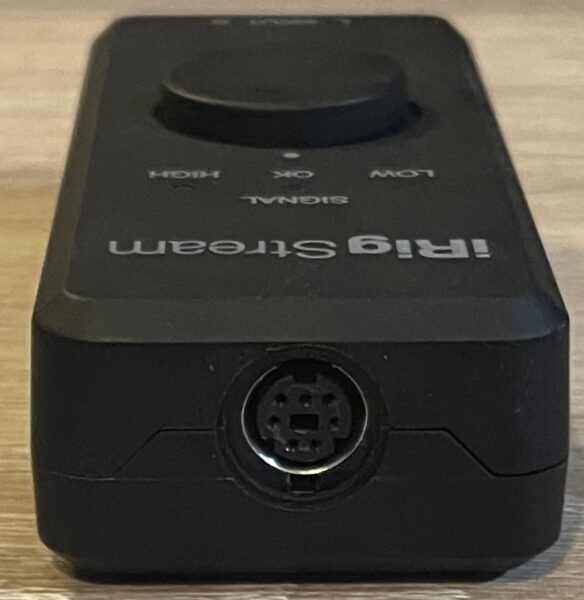
- DC power – Although not included, you can purchase a power supply for the iRig devices to run the interface and charge your phone as well. The iRig Stream uses a different PSU than the iRig Duo Pro.

- Capable of using a Camera connection kit to power via USB – This allows you to connect the iRig to your phone while simultaneously charging via a USB battery bank, giving you way more uptime.
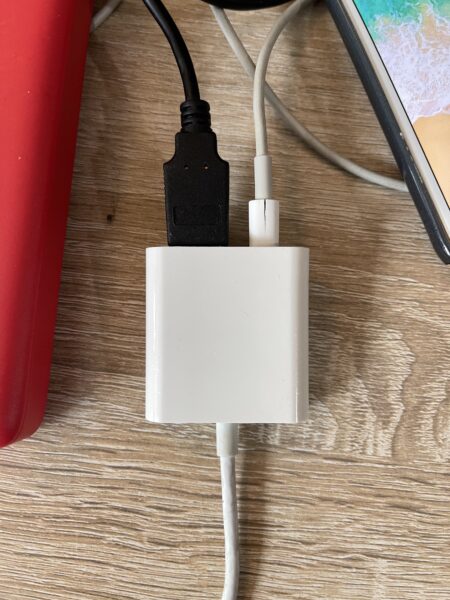
- It can be used as an interface for PCs – the iRig stream functions as a class-compliant sound card for your computer. Just plugin and select it as your interface.
- Loopback – This feature lets you input audio from the same device you have connected. If you have some audio sources on your phone (say a scratch looper), you can broadcast that and the external sources.
Cons:
- Limited Inputs – There’s only one set of inputs and a single headphone/mic 1/8″ combo jack.
- Shared headphone/microphone jack – Probably designed for headsets with built-in mics, but if you want to use an actual mic and headphones simultaneously, you can’t.

- 1/8″ input for mics – this is not a very standard connection vs. 1/4″, XLR, or combo jacks.
- DIN connection cable is proprietary – Meaning that if you lose it or it shorts out, you can only get a replacement direct from IK Multimedia.
Professional options
IK Multimedia iRig Pro Duo

The iRig Pro Duo is IK Multimedia’s higher-end option. It offers a few unique features that make it closer to a proper audio interface than a mobile phone card. The interface features a pair of XLR/1/4″ combo jacks for input, each with an independent volume knob. This is also the only card in this list that includes MIDI input and outputs (via 1/8″ jacks). It also has dedicated 1/4″ outputs that allow you to output audio using something more robust than a 1/8″ headphone out.
Build quality
The iRig Pro Duo is the sturdiest feel card of the lot. While still plastic, it has a reassuring weight that feels very solid. It has similar volume discs as the iRig Stream and the same volume dials and switches.
Pros:
- MIDI in/out – A pair of 1/8″ MIDI jacks allows you to use the Pro Duo as a MIDI interface to connect controllers to your phone, tablet, or PC.
- Dedicated 1/4″ outputs – This is the only card with more than one set of outputs. These outputs allow you to connect to both speakers and monitors more easily.
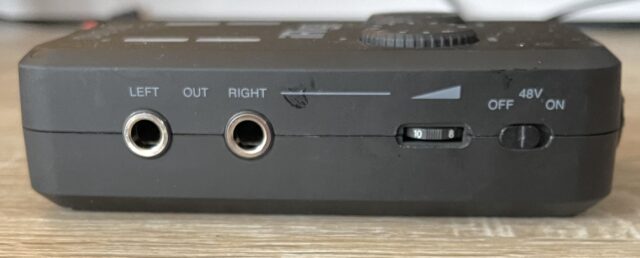
- 48V Phantom Power – This allows you to connect and power condenser microphones to the sound card.
- Level lights – Much like the iRig Stream, you have innovative signal lights and an added near-clip orange color that appears right before the red clipping light.

- DIN connector for the connection cable – same cable as the stream.
- XLR/1/4″ combo jack input – Which we find to be more professional and versatile than the RCA inputs of the Stream.
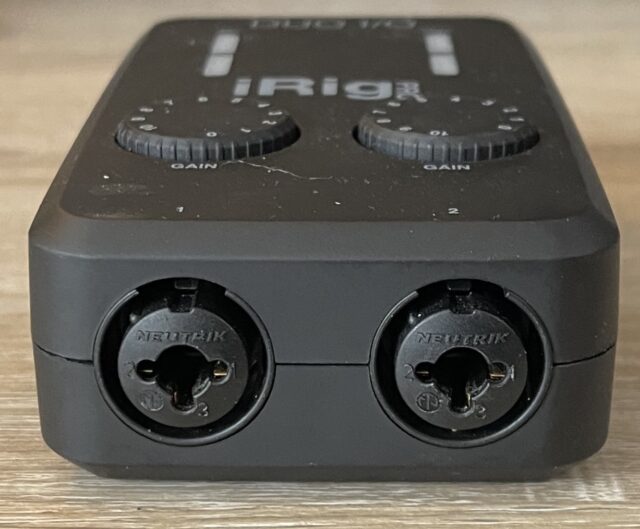
- DC power allows for charging your phone – Same as the stream as well.
- Capable of using a Camera connection kit to power via USB – Again, same as the iRig Stream – allowing for extended battery life and the ability to charge your phone.
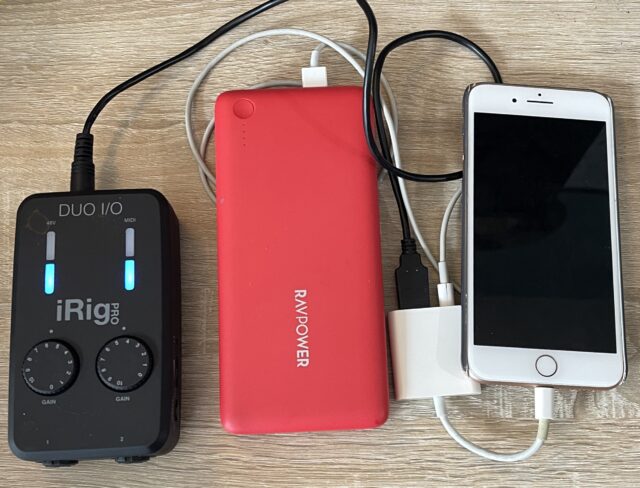
- Class Compliant sound card – Like its little sibling, the Pro Duo can also function as an audio interface for your mobile device as well as your pc. With the external outputs and the MIDI in/outs, this feels the most like a proper audio interface for music production instead of just being a recording interface.
Cons:
- Only one set of inputs – If you want to connect a mic with the Pro Duo, you’ll need to use up one of your precious inputs and will lose out on stereo sound.
- Dual input gains – As DJs, we will be using stereo sound almost exclusively, so having separate volume controls for the left and right channels isn’t the most ideal.
- Frequent disconnects/power cycling when batteries drain – There’s no indication when the batteries run low. As a result, the Pro Duo will start cutting in and out as it begins to die. I experienced this during one of my streams that I ultimately had to abandon due to the constant cutting of the audio.
- Issues with balanced TRS cable inputs – I recently discovered some issues using balanced 1/4″ cables, causing the audio to cut in and out. I was sure I wasn’t experiencing this issue earlier, so I am still investigating the cause of this. Using unbalanced TS cables seemed to solve this issue.
- Not USB bus-powered by phone – Batteries, a DC power adaptor, or a USB battery bank is required to run the iRig Pro Duo. If your batteries run out of juice, you’re out of luck with the Pro Duo without replacing the batteries.
- Orange, near-clip light – It’s a little challenging to distinguish between the orange and red lights. Yellow would have been a better choice.
GO:MIXER Pro X
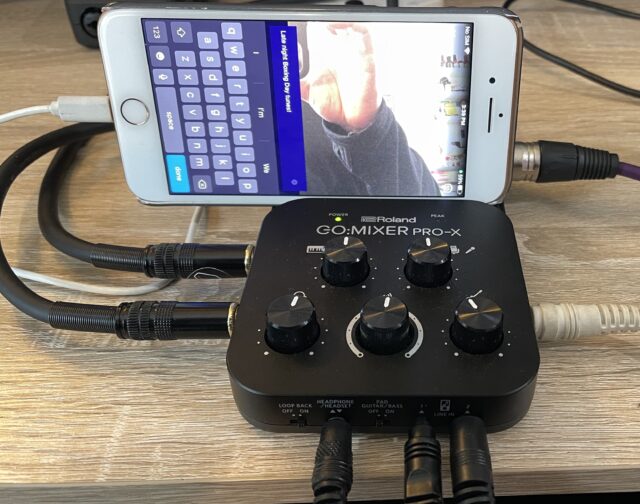
I haven’t used the original GO:MIXER Pro, so I can’t tell you what has changed other than the color. The Pro X contains even more inputs and outputs than the GO:MIXER. In addition to the two stereo 1/8″ inputs, a set of stereo 1/4″ inputs, and a mono 1/4″ input, there is an additional 1/8″ port to allow TRS cables to connect older smartphones for both input and output. The headphone out port also supports mic-in for headset use. The mic input is now an XLR/1/4″ combo jack instead of a 1/4″ input. In addition to the added inputs and outputs, the Pro X offers a pad switch for specific instruments to reduce the input volume. Finally, the Pro X also has a loopback switch similar to the one on the iRig Stream.
The GO:MIXER PRO X also allows for battery power; using 4 AAA batteries adds longevity to the unit.
Build quality
The GO:MIXER Pro X feels a lot better than the original GO:MIXER, but it has a light plastic feel. The knobs have a nice, chunkier feel, but there’s a decent amount of lateral wiggle to them. While plastic on the GO:MIXER Pro X feels relatively light, there’s a much more solid feel over the GO:MIXER.
Pros:
- Inputs – Even more robust series of inputs than the GO:MIXER, the GO:MIXER Pro X offers so much connectivity that even a small band would be happy.
- Dedicated XLR/1/4″ combo input for the mic – This is a much more versatile connection than the TS-only 1/4″ input of the GO:MIXER.

- 48V phantom power – The GO:MIXER PRO can power condenser mics directly. Apple devices require batteries, but it’s possible to run a condenser mic directly from the USB bus power on Android devices.
- Build – While not built like a tank or anything, it feels sturdier than the original GO:MIXER.
- Battery-powered – The 4 AAA batteries add a good amount of uptime to the GO:MIXER Pro X. In my experience, you can get about 6-8 hours off one set of batteries.
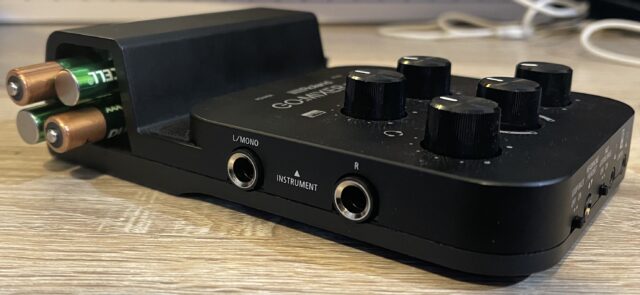
- Headroom – As mentioned, the Go Mixer Pro is much louder than the GO:MIXER thanks to the extra battery power.
- Loopback – Like the iRig Stream, Loopback can be used to record/stream audio coming directly from the phone.
- Battery power is not required – Capable of being 100% USB bus-powered.
- Functions as a standalone mixer – With the batteries, the GO:MIXER Pro X can function as a full mixer even without a phone connected.
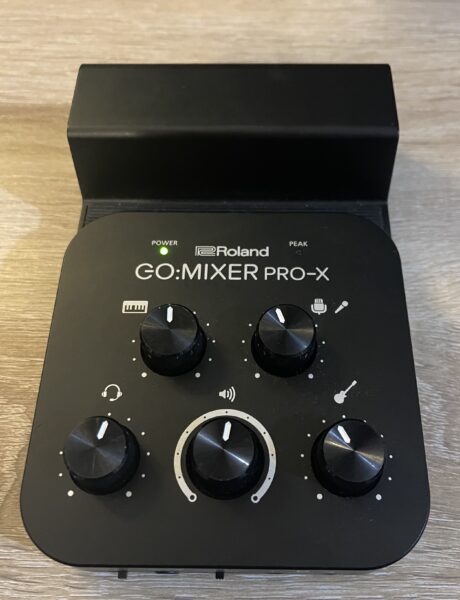
- The phone holder/shelf thingy – You can use this as a makeshift phone holder in the place of a tripod.
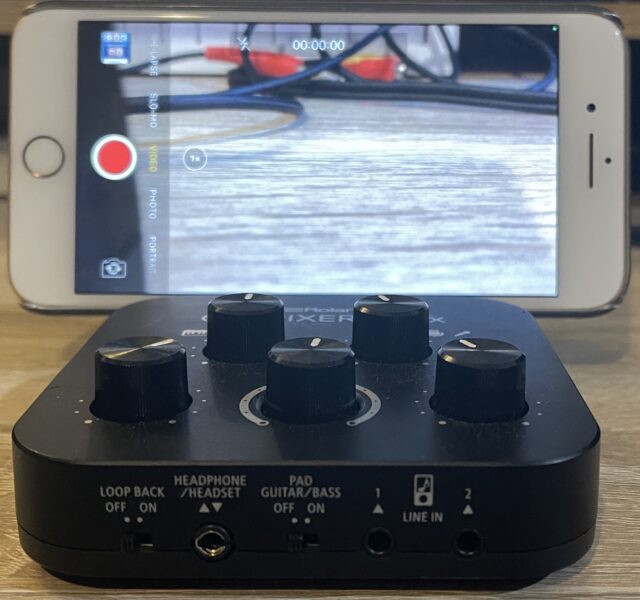
Cons:
- It has the same micro-USB connection – Given how quickly the GO:MIXER cable/port became problematic, the Pro X could have similar issues.
- Sound distorts with too much input gain – When the input gain is too hot, you hear audible distortion before the clip light goes on.
- It doesn’t work with a camera connection adaptor – Like the GO:MIXER, the Pro X does not function when using one of these dongles.
- There are no external power sources – While the GO:MIXER Pro X can use batteries and USB bus power, there is no additional way to provide power. It is 100% dependent on battery power – either via the AAA batteries or the battery on your device.
- No seamless switching from battery power to USB bus power – When the batteries drain, the card will completely power down until you flip the power switch to “off.” An automatic flip from the battery to USB bus power would be more convenient.
Comparing sound quality
Honestly, high-fidelity sound is not my top priority when looking to stream. There’s a fair amount of compression applied when streaming, so even the most professional interfaces will lose quality when broadcasting to the internet. That said, I was happy with the overall audio quality of all four cards. I find that the battery-powered cards offer a little more headroom; as long as you set a proper gain stage, all of these cards will sound good.
All four cards seemed susceptible to distortion when the source volume was too high. In the case of the Roland card, input gain would cause distortion even before the clip light came on. However, if you set the output source at a quieter level and turn up the recording gain, you can push the card a lot further before hearing audible distortion.
In the case of the iRig Pro Duo, the signal can go well into the orange, pre-clip light before hearing audible distortion. For the rest, you can blink the clip light without audible distortion. Therefore, mastering your gain stage is imperative for getting a clean audio signal from these devices.
The IK Multimedia cards list 24-bit resolution supporting 44.1k and 48k sample rates. Unfortunately, the Roland cards do not list their card specs, but they still sounded good to my ear.
Of the four, the iRig Pro Duo seemed to have the most headroom. But that may only be the inclusion of the pre-clip light psychologically letting you push the levels a little further.
Subjectively, I found the IK Multimedia cards a little punchier with more presence in the mids and highs. On the other hand, the Roland cards sounded a little flatter in sound to my ear.
Neither companies were exactly mind-blowing, but neither sounded poor to my ear either.
IK Multimedia vs Roland
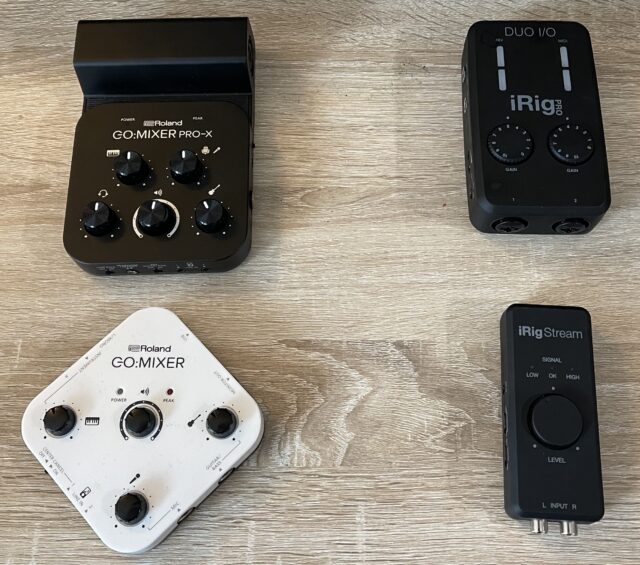
From my experience testing these options, it’s clear that each company focuses on specific areas in which they excel. However, weaknesses in their design choices are also necessary to consider when deciding which to purchase.
Roland
Pros:
For Roland, the GO:MIXER lineup will appeal the most if you need multiple inputs and want to connect various pieces of gear to record/broadcast. Over the summer, I made several videos using my battery-powered setup, and the Roland cards worked out nicely. It allowed me to connect my controller, add my portable turntable, and even connect other controllers and a mic for jam sessions and livestreams. If you use controllers without auxiliary inputs, having the option to connect multiple audio sources is a plus. As I am slowly amassing a collection of outboard synths and hardware music production gear, routing various equipment through the card is very attractive. I also like using a mic that only outputs to the stream rather than running microphone audio over the speakers. It’s beneficial to engage with your streaming audience without bothering your live audience.
Cons:
The biggest weakness of the Roland cards is the lack of external power options. While the GO:MIXER Pro X does offer optional battery power in the form of AAA batteries, those batteries go pretty quick with prolonged use. With a fully charged phone plus fresh batteries, I was able to get about 8 hours of streaming time on the Pro X (2 sessions without replacing the battery). I highly recommend rechargeable batteries with the GO:MIXER Pro X.
Not having Camera Connection kit support is a pretty big miss for me – as is the lack of a DC port.
IK Multimedia
Pros:
The main strength of the iRig gear is the ability to use an external power source with the cards. Using the DC port with a wall plug or USB adaptor or a Camera Connection kit with a power bank gave me much more streaming time than the Roland cards. I found myself streaming at my gigs more at lounge and restaurant nights most often. These gigs tend to last a good 4-5 hours, so not relying on my phone battery charge was a huge plus for my uses.
Another plus with the iRig cards is the connectivity with more than just mobile devices. For example, if you need an audio device for your PC, the iRig can double as that (especially the Pro Duo with its 1/4″ outputs), allowing for more flexibility in use.
Cons:
The drawback to using these external power sources is the added cost required. A camera connection kit and high-powered USB battery bank can easily add $50 – $100+ to the card’s price. Even getting the power adaptor will cost extra.
Another critical weakness of the iRig cards is the lack of inputs. The iRig Stream has the advantage because of the 1/8″ mic input shared with the headphone output. Still, it’s not a very common connector type, and the iRig Duo could use a dedicated mic input to go with the Stereo ins.
Which to choose?

Ultimately, I think both types of cards have their place. I would recommend the Roland cards more for shorter sessions, using it for creating videos, or for more performance-based uses – say, an impromptu jam session in the park consisting of more than just DJing. The IK Multimedia cards work a lot better for lengthy sessions and streams, thanks to the flexibility of power sources.
I would heavily recommend the GO:MIXER Pro X over the original GO:MIXER due to the added battery power. With the original GO:MIXER, I was getting at most, 3-4 hours off a fully-charged phone battery – and that’s with a robust, reasonably new iPhone 12 Plus. I was lucky with my older phone if I got 1-2 hours. However, this is somewhat moot since the original GO:MIXER is a little challenging to find. We may be seeing a refresh soon, though.
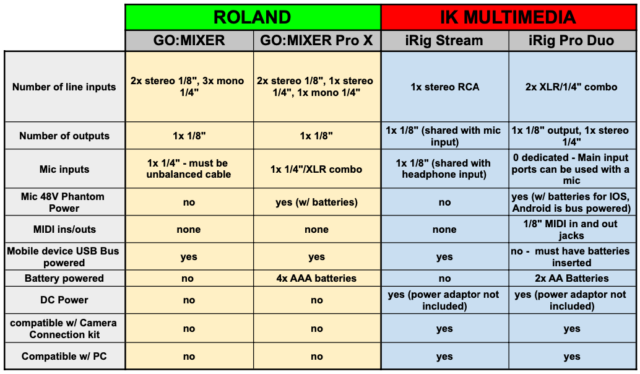
Our picks:
Of the IK Multimedia cards, the iRig Stream is my preferred pick. Yes, the iRig Pro Duo has more professional inputs and outputs and includes the MIDI in/outs. But unless you need a portable audio card for mobile music production, the iRig Stream is definitely enough for your mobile streams. It’s also worth noting that the recently-released iRig Stream Pro addresses some of the problems on the stream, and could be a solid option (IK Multimedia has since sent me a Stream Pro, so I may be doing a review on it soon).
Overall, each of these cards offers many features and a quality way to take your stream on the go. But, of course, most DJs looking to stream off their phone would be happy with either, depending on their priorities.
Looking to mobile stream? The IK Multimedia Steam Go and IK Multimedia Stream Pro Duo are in the DJTT shop for $99 and $199 respectively. The Roland GO:MIXER Pro X is available at most music stores for $199, but the original Roland GO:MIXER may be more difficult to find – you may need to scour the used market.





